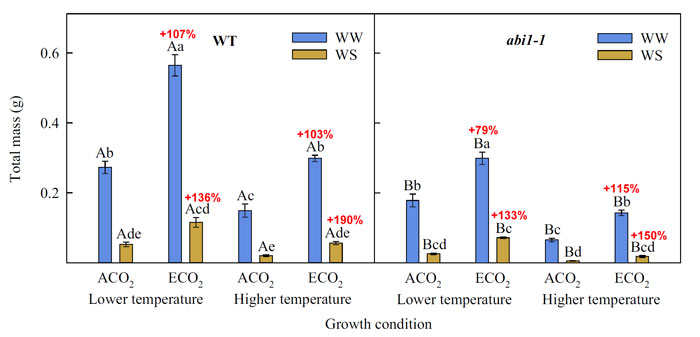| Tweet | Follow @co2science |
Paper Reviewed
Gamar, M.I.A., Kisiala, A., Emery, R.J.N., Yeung, E.C., Stone, S.L. and Qaderi, M.M. 2019. Elevated carbon dioxide decreases the adverse effects of higher temperature and drought stress by mitigating oxidative stress and improving water status in Arabidopsis thaliana. Planta 250: 1191-1214.
Noting that many CO2 enrichment studies have "considered the effects of individual components of climate change on plants," but that "very few have assessed the interactive effects of [multiple] stress factors," Gamar et al. set out to examine the combined impact of CO2, temperature stress and water stress on two genotypes of thale cress (Arabidopsis thaliana).
The two genotypes included ecotypes of the cultivar Landsberg erecta, one defined as a wild type (WT) and the other as a mutant insensitive to the phytohormone abscisic acid (abil-1). The plants were grown in controlled-environment growth chambers under one of two regimes of temperature (ambient at 22/18 °C day/night or stressed at 28/24 °C day/night), water status (well-watered or water-stressed) and CO2 concentration (ambient at 400 ppm or elevated at 700 ppm). The experiment lasted 18 days after which the authors determined various plant growth, anatomical, physiological, molecular and hormonal responses elucidated from the different treatment conditions.
It was no surprise that temperature stress and water stress both negatively impacted plant growth while elevated CO2 improved it. In this regard, plant leaf number, leaf area, rosette diameter were all enhanced by CO2. In addition, CO2 enrichment significantly improved the root, leaf and total biomass of A. thaliana. Total dry mass, for example, is shown in Figure 1 below, illustrating CO2-induced increases of 79-190% for a given temperature and water regime.
Elevated CO2 also improved leaf and soil water potential, leaf moisture, cell area, and ethylene evolution. Furthermore, it altered plant stomatal and cell density, photosynthetic pigments, proline level, malondialdehyde content, electrical conductivity, abscisic acid amounts and total cytokinins in such a way to mitigate many of the negative effects of water and temperature stress on A. thaliana. Essentially, elevated CO2 improved the photosynthetic apparatus and enabled the reallocation of resources into other growth-limiting processes and/or stress defenses (such as antioxidant defense or water status improvement) so as to limit the negative effects of temperature and water stress. And that is a pretty powerful and welcomed response for a molecule that far too many wrongfully consider to be a pollutant.

Figure 1. Effects of temperature, carbon dioxide, and watering regime on total dry mass accumulation of 18-day-old A. thaliana plants. The left panel presents data for the WT genotype and the right panel for the ABA-insensitive mutant, abil-1. Lower temperature = 22/18 °C (day/night), higher temperature = 28/24 °C (day/night), ACO2 = 400 ppm, ECO2 = 700 ppm, WW = well-watered (blue shaded bars) and WS = water-stressed (brown shaded bars). Different letters above the bars (mean ± SE) denote significant differences within each parameter according to Scheffé's test. Uppercase letters represent differences between genotypes, whereas lowercase letters represent differences within genotypes. The percentages in red text indicate the percent change in total biomass due to CO2 for a given temperature and water regime. Adapted from Gamar et al. (2019).




